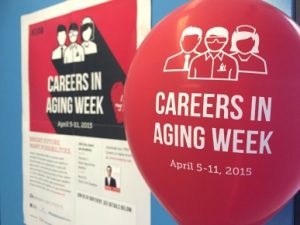Luskin Students and Professors Tackle the “Silver Tsumani” of Aging America The economics and logistics of an aging population presents one of the greatest challenges to social welfare

By Adeney Zo
UCLA Luskin Student Writer
Gerontology and social welfare go hand in hand, and the intersection of these two fields may be the key to solving America’s future. As the largest living generation in America (the “Baby Boomers”) enters retirement age, there is a growing demand for professionals trained to work with the elderly.
“Many researchers are calling the aging of America’s population the “silver tsunami” because the demographics of the country are so dramatically shifting in the direction of 65+ age group,” said social welfare student and researcher Hayley Schleifstein.
At the Luskin School, student organizations like the Gerontology & Geriatrics Interest Group (GIG) and the Social Welfare Gerontology Caucus work to raise awareness and interest in working with the aged population. “My research interest is getting young people involved,” said Lia Marshall, a social welfare doctoral student. “I want to introduce them to this idea when they’re young and maybe 10 years from now, it might be their career.”
But the Baby Boomer generation is not the only large population in America – the current generation of Millenials (ages 18-34) are about to surpass the Baby Boomers in population size.
“This will be the first time in 150 years where there are as many individuals, 80 million, in Millenials as Baby Boomers,” said Social Welfare and Public Policy professor Fernando Torres-Gil.
For America, this statistic means that the same number of people will be simultaneously entering the work force and retiring – and that the Millenials will be funding social benefits (Social Security, Medicare, etc.) for the Baby Boomers while carrying the knowledge that those benefits may well be gone by their own retirement.
Professor Torres-Gil’s research tackles these difficult policy issues along with the political implications of aging. His work is aimed towards finding policy solutions for a large aging population and creating new structures of support for future generations. “There is no consensus about how to provide reasonable quality of life for the elderly,” said Torres-Gil. “These [issues] go right into the heart of policy, politics, and visceral concerns. People wonder: Who will take care of me when I’m old? Congress is divided because the public is divided.”
However, there may be hope for the future brewing at UCLA. “The good news is that UCLA has very active young people and clubs volunteering for senior programs. We even have an undergraduate minor in gerontology,” said Torres-Gil. “Once we educate people, they are much more open and interested.”
On April 9, the Luskin School hosted its first Careers in Aging Week event to highlight professional opportunities in gerontology as well as its importance to this generation. “Careers in Aging Week” is an annual, nationwide movement sponsored by the Gerontological Society of America (GSA) that draws attention to growing career opportunities with the aging population.
Valerie Coleman, an organizer for the Luskin Careers in Aging Week, entered Urban Planning with a distinct interest in working with the aging population. “When I came into the Luskin, my classmates were surprised at my interest,” said Coleman. “So last year, I coordinated an event with Luskin students about working with the aging population and how it will affect all our careers.”
This year, Coleman teamed up with Zoe Koehler, co-chair for the Gerontology Caucus, and Lia Marshall, co-coordinator for GIG, to coordinate an official Careers in Aging Week event.
“I was especially impressed at the varied turnout at our Networking event, in which a few business and economics students showed up,” said Koehler. “This goes to show that the issue of our aging society is and will be relevant to students of all disciplines.”
The UCLA event featured an afternoon panel with a multidisciplinary array of leaders in the field of aging and aging research, including Professor Torres-Gil. The panel was followed by a networking event that allowed for participants to interact with professionals from the field and discover the variety of opportunities connected to the aging population.
“Careers in Aging is an important event right now because by 2050, 1 out of 5 people will be over the age of 65,” said Koehler. “Whether UCLA students intentionally choose to go specifically into work with seniors or not, they will be working with seniors. We want to help prepare students for the reality of our rapidly shifting and aging demographic in this country.”
To learn more about gerontology at Luskin, visit the GIG website at:


Leave a Reply
Want to join the discussion?Feel free to contribute!